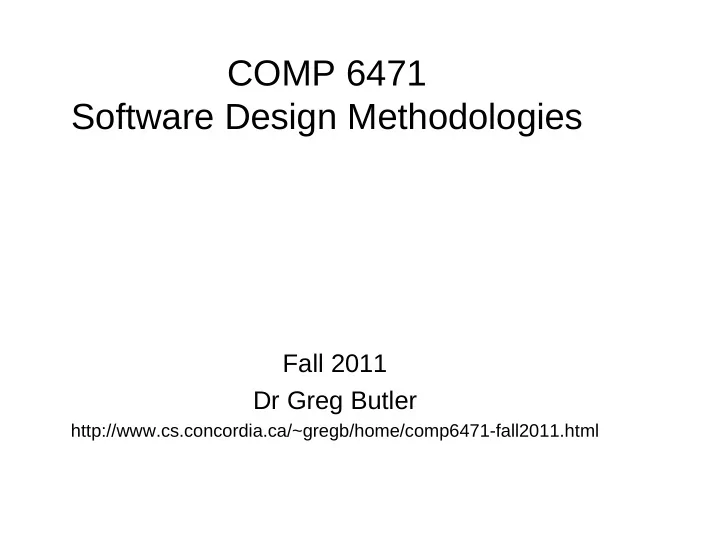

COMP 6471 Software Design Methodologies Fall 2011 Dr Greg Butler http://www.cs.concordia.ca/~gregb/home/comp6471-fall2011.html
A Classification of Software Architectures
Components: Classes & Objects Connectors: Method calls
Data Abstraction & OO : Strengths • Naturally supports information hiding, which shields implementation changes from clients • Encapsulation and information hiding reduce coupling => Enhances maintainability • Allows systems to be modeled as collection of collaborating objects => can be an effective means of managing system complexity
Data Abstraction & OO : Weaknesses • Object identity must be known for method invocation => Identity change of an object affects all calling objects ▫ Contrast this to pipe-and-filter … • Concurrency problems through concurrent access
Implicit Invocation The idea behind implicit invocation is that instead of invoking a procedure directly, a component can announce (or broadcast) one or more Events. Other components in the system can register an interest in an event by associating a procedure with the event. When the event is announced the system itself invokes all of the procedures that have been registered for the event. Thus an event announcement ``implicitly'' causes the invocation of procedures in other modules.
Event-Driven Architecture Style
Event-Driven: Communication protocols • Synchronous communication is direct, time synchronized. This means that all parties involved in the communication are present at the same time. ▫ Examples are: A telephone conversation (not texting), a company board meeting, a chat room event and instant messaging. ▫ • Asynchronous communication does not require that all parties involved in the communication to be present at the same time. ▫ Examples are: e-mail messages, discussion boards, blogging, and text messaging over cell phones.
Event-Driven Architecture • Component: (active or passive) object, capsule, module ▫ Can be an instance of a class, an active class, or simply a module. ▫ Interface provides methods and ports. ▫ Publisher: individual components announce data that they wish to share with their subscribers. ▫ Subscriber: individual components register their interest for published data. • Connector: “connector”, channel, binding, callback. ▫ Offers one-to-one, one-to-many, many-to-one connections; ▫ Asynchronous event broadcast. ▫ Synchronous event broadcast & await reply (call-and-return) • Components do not explicitly invoke each other. • Components generate signals , also called events . • To receive events, objects can ▫ Receive events at ports (statically or dynamically bound). ▫ Register for event notification (e.g. via callback). • Announcers do not know which components will be affected by thrown events • System framework implements signal propagation
Event-Driven Architecture Strengths • Supports reuse ▫ Only little coupling • Easy system evolution ▫ Introduction of new component simply by registering • Well suited for asynchronous communication • Weaknesses • Components don’t have control over computation since they can only generate events; the run-time system handles event dispatching. Thus Respondents to events are not ordered. • Exchange of data can require use of global variables or shared repository => resource management can become a challenge. • Global system analysis is more challenging. • Asynchronous event handling • Contrast to explicit call & use of pre-, post-conditions. E.g. how to ensure that at least one object has processed an event.
Event-Driven Architecture: Examples • UIs ▫ Macintosh computers popularized the “main event loop” approach for UI applications. • Other examples include ▫ Constraint satisfaction systems (e.g. some database systems). ▫ Daemons. ▫ S/W environments that make use of multiple tools: e.g. text editor registers for events from debugger.
Distributed Peer-to-Peer Systems • Components ▫ Independently developed objects and programs offering public operations or services • Connectors ▫ Remote procedure call (RPC) over computer networks • Configurations ▫ Transient or persistent connections between cooperating components • Underlying computational model ▫ Synchronous or asynchronous invocation of operations or services • Stylistic invariants ▫ Communications are point-to-point
Recommend
More recommend